Impact of Social Media Marketing
VerifiedAdded on 2019/09/30
|11
|3676
|289
Report
AI Summary
This report investigates the impact of social media marketing on the performance of micro and small businesses. It explores how social media is changing marketing strategies in India, using qualitative data from interviews with social media experts. The report examines social media's role in internal communication, customer engagement, and brand building. It highlights the transformative potential of social media for businesses of all sizes, contrasting it with traditional marketing methods. The study also analyzes consumer behavior and the influence of social media on purchasing decisions, emphasizing the importance of word-of-mouth marketing and the shift from one-to-many to one-to-one communication. The report includes a literature review examining various perspectives on social media's role in brand equity, recruitment, and risk management. Finally, it presents research objectives, hypotheses, and a methodology for exploring the association between social media usage, online promotional activities, and business benefits.
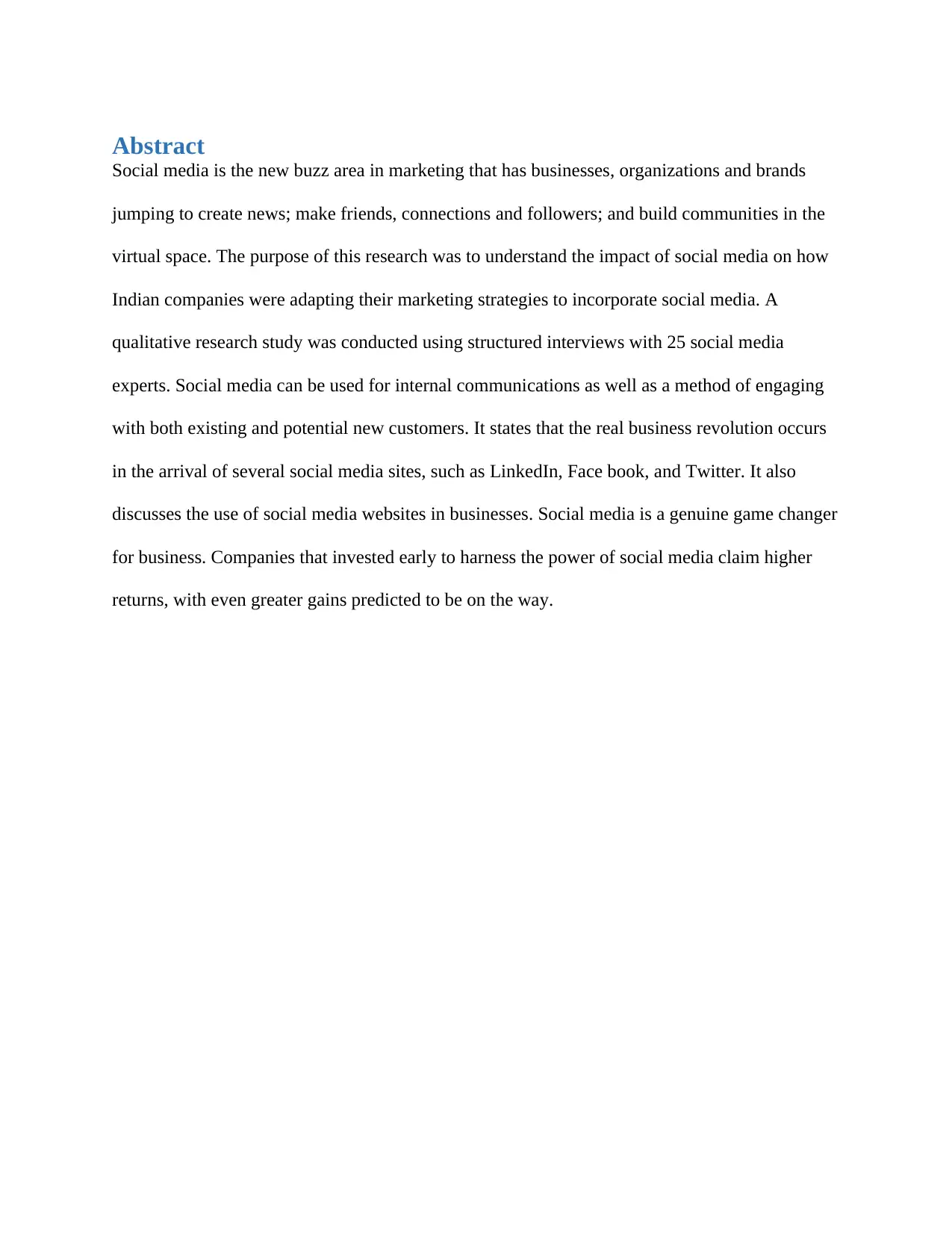
Abstract
Social media is the new buzz area in marketing that has businesses, organizations and brands
jumping to create news; make friends, connections and followers; and build communities in the
virtual space. The purpose of this research was to understand the impact of social media on how
Indian companies were adapting their marketing strategies to incorporate social media. A
qualitative research study was conducted using structured interviews with 25 social media
experts. Social media can be used for internal communications as well as a method of engaging
with both existing and potential new customers. It states that the real business revolution occurs
in the arrival of several social media sites, such as LinkedIn, Face book, and Twitter. It also
discusses the use of social media websites in businesses. Social media is a genuine game changer
for business. Companies that invested early to harness the power of social media claim higher
returns, with even greater gains predicted to be on the way.
Social media is the new buzz area in marketing that has businesses, organizations and brands
jumping to create news; make friends, connections and followers; and build communities in the
virtual space. The purpose of this research was to understand the impact of social media on how
Indian companies were adapting their marketing strategies to incorporate social media. A
qualitative research study was conducted using structured interviews with 25 social media
experts. Social media can be used for internal communications as well as a method of engaging
with both existing and potential new customers. It states that the real business revolution occurs
in the arrival of several social media sites, such as LinkedIn, Face book, and Twitter. It also
discusses the use of social media websites in businesses. Social media is a genuine game changer
for business. Companies that invested early to harness the power of social media claim higher
returns, with even greater gains predicted to be on the way.
Paraphrase This Document
Need a fresh take? Get an instant paraphrase of this document with our AI Paraphraser
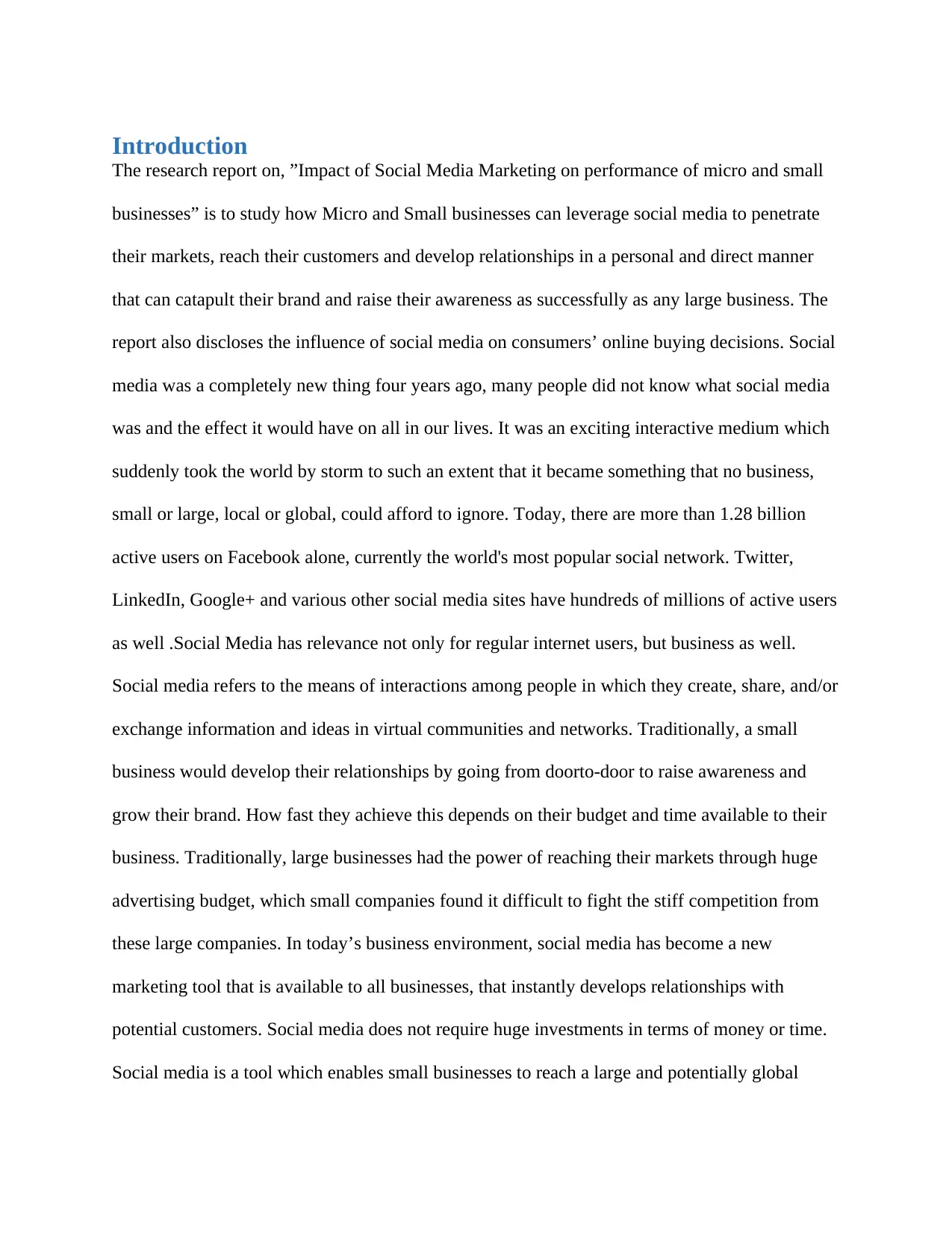
Introduction
The research report on, ”Impact of Social Media Marketing on performance of micro and small
businesses” is to study how Micro and Small businesses can leverage social media to penetrate
their markets, reach their customers and develop relationships in a personal and direct manner
that can catapult their brand and raise their awareness as successfully as any large business. The
report also discloses the influence of social media on consumers’ online buying decisions. Social
media was a completely new thing four years ago, many people did not know what social media
was and the effect it would have on all in our lives. It was an exciting interactive medium which
suddenly took the world by storm to such an extent that it became something that no business,
small or large, local or global, could afford to ignore. Today, there are more than 1.28 billion
active users on Facebook alone, currently the world's most popular social network. Twitter,
LinkedIn, Google+ and various other social media sites have hundreds of millions of active users
as well .Social Media has relevance not only for regular internet users, but business as well.
Social media refers to the means of interactions among people in which they create, share, and/or
exchange information and ideas in virtual communities and networks. Traditionally, a small
business would develop their relationships by going from doorto-door to raise awareness and
grow their brand. How fast they achieve this depends on their budget and time available to their
business. Traditionally, large businesses had the power of reaching their markets through huge
advertising budget, which small companies found it difficult to fight the stiff competition from
these large companies. In today’s business environment, social media has become a new
marketing tool that is available to all businesses, that instantly develops relationships with
potential customers. Social media does not require huge investments in terms of money or time.
Social media is a tool which enables small businesses to reach a large and potentially global
The research report on, ”Impact of Social Media Marketing on performance of micro and small
businesses” is to study how Micro and Small businesses can leverage social media to penetrate
their markets, reach their customers and develop relationships in a personal and direct manner
that can catapult their brand and raise their awareness as successfully as any large business. The
report also discloses the influence of social media on consumers’ online buying decisions. Social
media was a completely new thing four years ago, many people did not know what social media
was and the effect it would have on all in our lives. It was an exciting interactive medium which
suddenly took the world by storm to such an extent that it became something that no business,
small or large, local or global, could afford to ignore. Today, there are more than 1.28 billion
active users on Facebook alone, currently the world's most popular social network. Twitter,
LinkedIn, Google+ and various other social media sites have hundreds of millions of active users
as well .Social Media has relevance not only for regular internet users, but business as well.
Social media refers to the means of interactions among people in which they create, share, and/or
exchange information and ideas in virtual communities and networks. Traditionally, a small
business would develop their relationships by going from doorto-door to raise awareness and
grow their brand. How fast they achieve this depends on their budget and time available to their
business. Traditionally, large businesses had the power of reaching their markets through huge
advertising budget, which small companies found it difficult to fight the stiff competition from
these large companies. In today’s business environment, social media has become a new
marketing tool that is available to all businesses, that instantly develops relationships with
potential customers. Social media does not require huge investments in terms of money or time.
Social media is a tool which enables small businesses to reach a large and potentially global
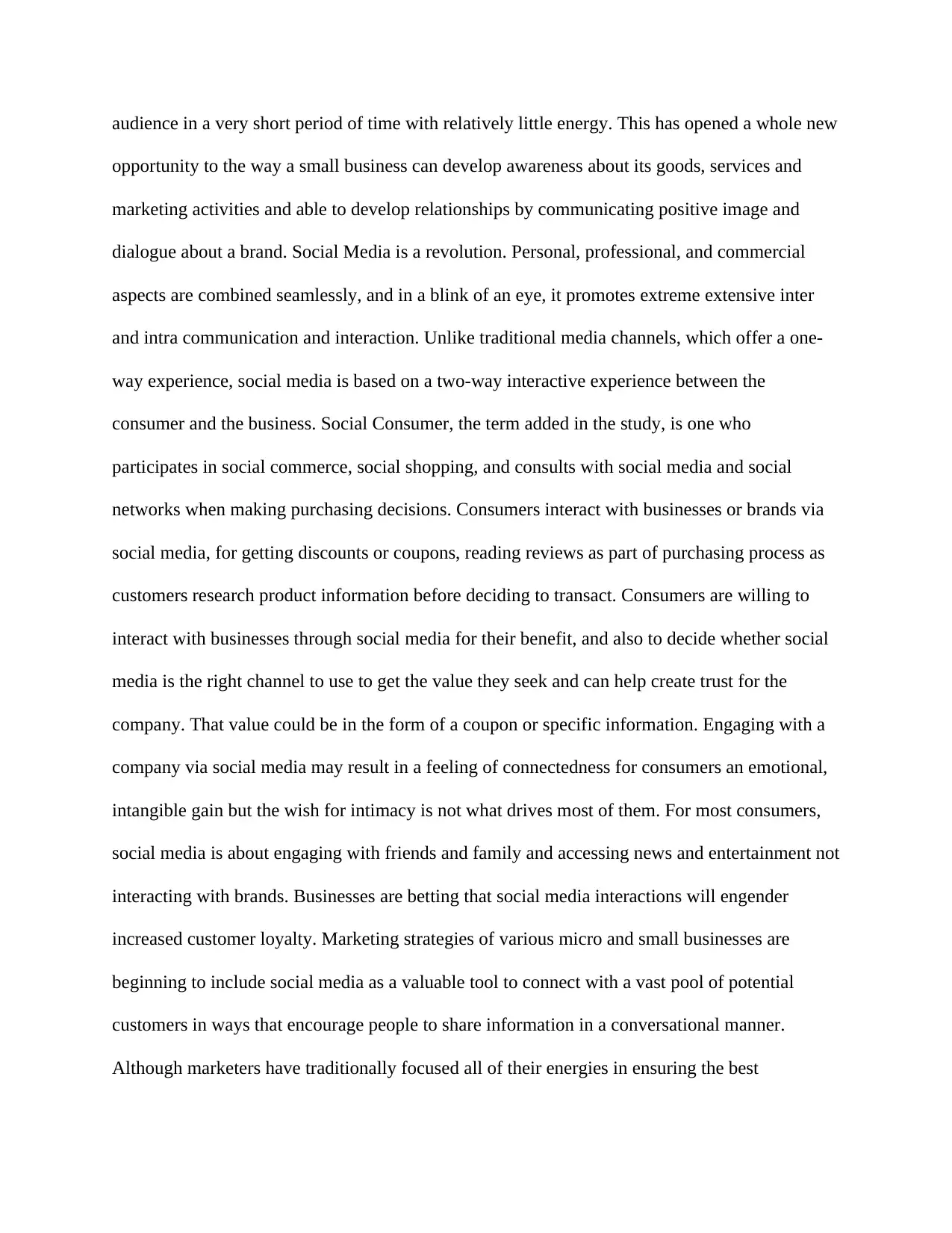
audience in a very short period of time with relatively little energy. This has opened a whole new
opportunity to the way a small business can develop awareness about its goods, services and
marketing activities and able to develop relationships by communicating positive image and
dialogue about a brand. Social Media is a revolution. Personal, professional, and commercial
aspects are combined seamlessly, and in a blink of an eye, it promotes extreme extensive inter
and intra communication and interaction. Unlike traditional media channels, which offer a one-
way experience, social media is based on a two-way interactive experience between the
consumer and the business. Social Consumer, the term added in the study, is one who
participates in social commerce, social shopping, and consults with social media and social
networks when making purchasing decisions. Consumers interact with businesses or brands via
social media, for getting discounts or coupons, reading reviews as part of purchasing process as
customers research product information before deciding to transact. Consumers are willing to
interact with businesses through social media for their benefit, and also to decide whether social
media is the right channel to use to get the value they seek and can help create trust for the
company. That value could be in the form of a coupon or specific information. Engaging with a
company via social media may result in a feeling of connectedness for consumers an emotional,
intangible gain but the wish for intimacy is not what drives most of them. For most consumers,
social media is about engaging with friends and family and accessing news and entertainment not
interacting with brands. Businesses are betting that social media interactions will engender
increased customer loyalty. Marketing strategies of various micro and small businesses are
beginning to include social media as a valuable tool to connect with a vast pool of potential
customers in ways that encourage people to share information in a conversational manner.
Although marketers have traditionally focused all of their energies in ensuring the best
opportunity to the way a small business can develop awareness about its goods, services and
marketing activities and able to develop relationships by communicating positive image and
dialogue about a brand. Social Media is a revolution. Personal, professional, and commercial
aspects are combined seamlessly, and in a blink of an eye, it promotes extreme extensive inter
and intra communication and interaction. Unlike traditional media channels, which offer a one-
way experience, social media is based on a two-way interactive experience between the
consumer and the business. Social Consumer, the term added in the study, is one who
participates in social commerce, social shopping, and consults with social media and social
networks when making purchasing decisions. Consumers interact with businesses or brands via
social media, for getting discounts or coupons, reading reviews as part of purchasing process as
customers research product information before deciding to transact. Consumers are willing to
interact with businesses through social media for their benefit, and also to decide whether social
media is the right channel to use to get the value they seek and can help create trust for the
company. That value could be in the form of a coupon or specific information. Engaging with a
company via social media may result in a feeling of connectedness for consumers an emotional,
intangible gain but the wish for intimacy is not what drives most of them. For most consumers,
social media is about engaging with friends and family and accessing news and entertainment not
interacting with brands. Businesses are betting that social media interactions will engender
increased customer loyalty. Marketing strategies of various micro and small businesses are
beginning to include social media as a valuable tool to connect with a vast pool of potential
customers in ways that encourage people to share information in a conversational manner.
Although marketers have traditionally focused all of their energies in ensuring the best
⊘ This is a preview!⊘
Do you want full access?
Subscribe today to unlock all pages.

Trusted by 1+ million students worldwide
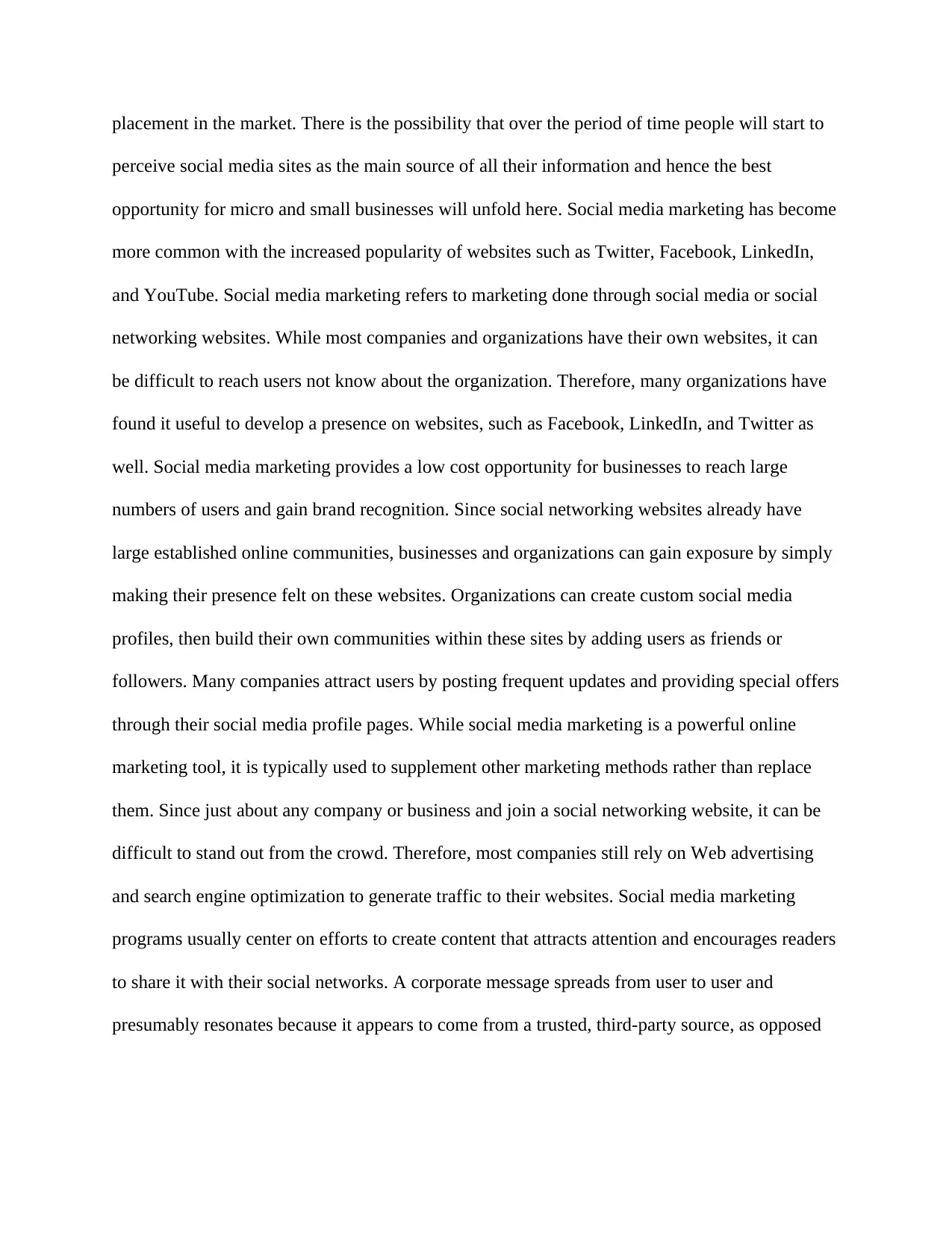
placement in the market. There is the possibility that over the period of time people will start to
perceive social media sites as the main source of all their information and hence the best
opportunity for micro and small businesses will unfold here. Social media marketing has become
more common with the increased popularity of websites such as Twitter, Facebook, LinkedIn,
and YouTube. Social media marketing refers to marketing done through social media or social
networking websites. While most companies and organizations have their own websites, it can
be difficult to reach users not know about the organization. Therefore, many organizations have
found it useful to develop a presence on websites, such as Facebook, LinkedIn, and Twitter as
well. Social media marketing provides a low cost opportunity for businesses to reach large
numbers of users and gain brand recognition. Since social networking websites already have
large established online communities, businesses and organizations can gain exposure by simply
making their presence felt on these websites. Organizations can create custom social media
profiles, then build their own communities within these sites by adding users as friends or
followers. Many companies attract users by posting frequent updates and providing special offers
through their social media profile pages. While social media marketing is a powerful online
marketing tool, it is typically used to supplement other marketing methods rather than replace
them. Since just about any company or business and join a social networking website, it can be
difficult to stand out from the crowd. Therefore, most companies still rely on Web advertising
and search engine optimization to generate traffic to their websites. Social media marketing
programs usually center on efforts to create content that attracts attention and encourages readers
to share it with their social networks. A corporate message spreads from user to user and
presumably resonates because it appears to come from a trusted, third-party source, as opposed
perceive social media sites as the main source of all their information and hence the best
opportunity for micro and small businesses will unfold here. Social media marketing has become
more common with the increased popularity of websites such as Twitter, Facebook, LinkedIn,
and YouTube. Social media marketing refers to marketing done through social media or social
networking websites. While most companies and organizations have their own websites, it can
be difficult to reach users not know about the organization. Therefore, many organizations have
found it useful to develop a presence on websites, such as Facebook, LinkedIn, and Twitter as
well. Social media marketing provides a low cost opportunity for businesses to reach large
numbers of users and gain brand recognition. Since social networking websites already have
large established online communities, businesses and organizations can gain exposure by simply
making their presence felt on these websites. Organizations can create custom social media
profiles, then build their own communities within these sites by adding users as friends or
followers. Many companies attract users by posting frequent updates and providing special offers
through their social media profile pages. While social media marketing is a powerful online
marketing tool, it is typically used to supplement other marketing methods rather than replace
them. Since just about any company or business and join a social networking website, it can be
difficult to stand out from the crowd. Therefore, most companies still rely on Web advertising
and search engine optimization to generate traffic to their websites. Social media marketing
programs usually center on efforts to create content that attracts attention and encourages readers
to share it with their social networks. A corporate message spreads from user to user and
presumably resonates because it appears to come from a trusted, third-party source, as opposed
Paraphrase This Document
Need a fresh take? Get an instant paraphrase of this document with our AI Paraphraser
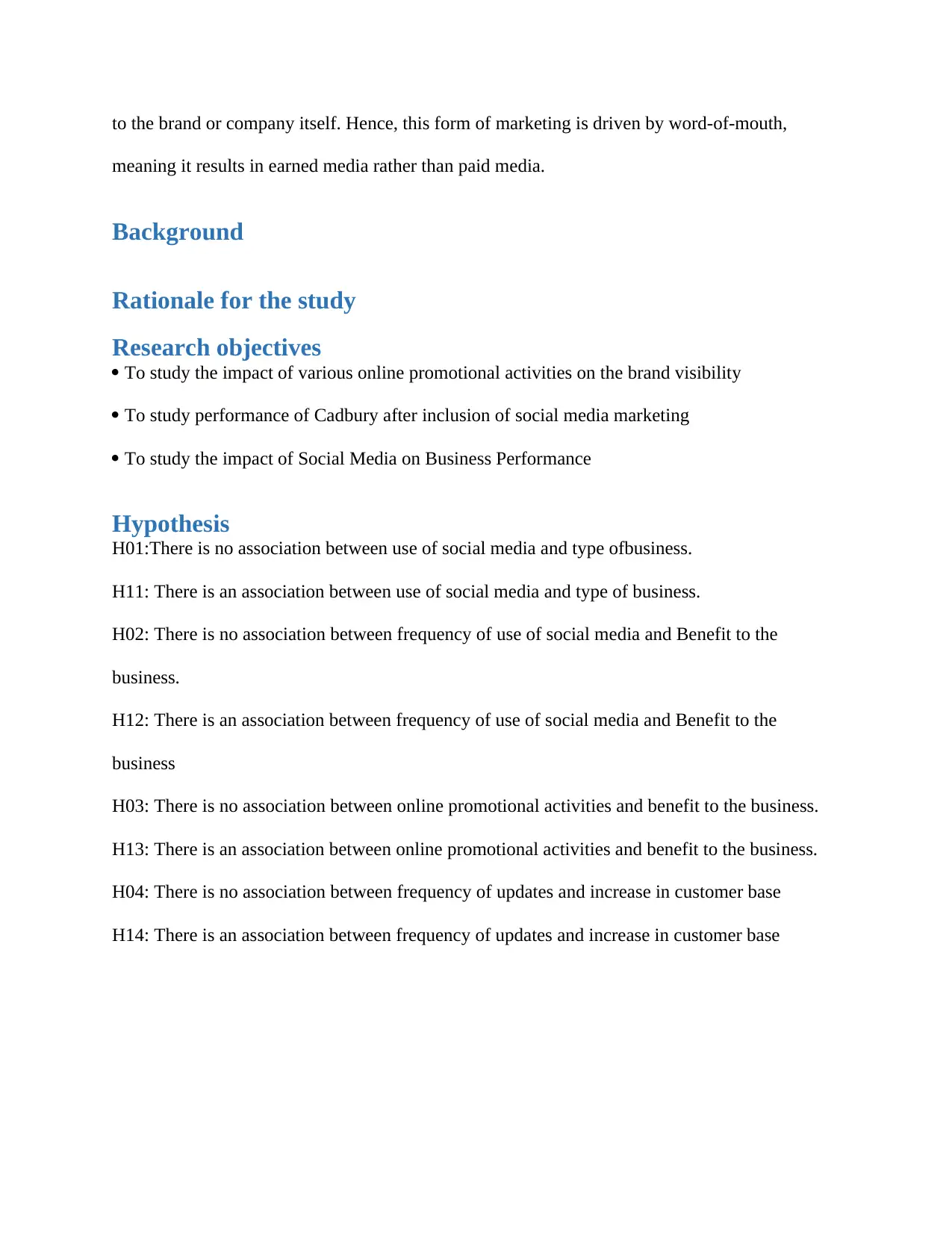
to the brand or company itself. Hence, this form of marketing is driven by word-of-mouth,
meaning it results in earned media rather than paid media.
Background
Rationale for the study
Research objectives
To study the impact of various online promotional activities on the brand visibility
To study performance of Cadbury after inclusion of social media marketing
To study the impact of Social Media on Business Performance
Hypothesis
H01:There is no association between use of social media and type ofbusiness.
H11: There is an association between use of social media and type of business.
H02: There is no association between frequency of use of social media and Benefit to the
business.
H12: There is an association between frequency of use of social media and Benefit to the
business
H03: There is no association between online promotional activities and benefit to the business.
H13: There is an association between online promotional activities and benefit to the business.
H04: There is no association between frequency of updates and increase in customer base
H14: There is an association between frequency of updates and increase in customer base
meaning it results in earned media rather than paid media.
Background
Rationale for the study
Research objectives
To study the impact of various online promotional activities on the brand visibility
To study performance of Cadbury after inclusion of social media marketing
To study the impact of Social Media on Business Performance
Hypothesis
H01:There is no association between use of social media and type ofbusiness.
H11: There is an association between use of social media and type of business.
H02: There is no association between frequency of use of social media and Benefit to the
business.
H12: There is an association between frequency of use of social media and Benefit to the
business
H03: There is no association between online promotional activities and benefit to the business.
H13: There is an association between online promotional activities and benefit to the business.
H04: There is no association between frequency of updates and increase in customer base
H14: There is an association between frequency of updates and increase in customer base
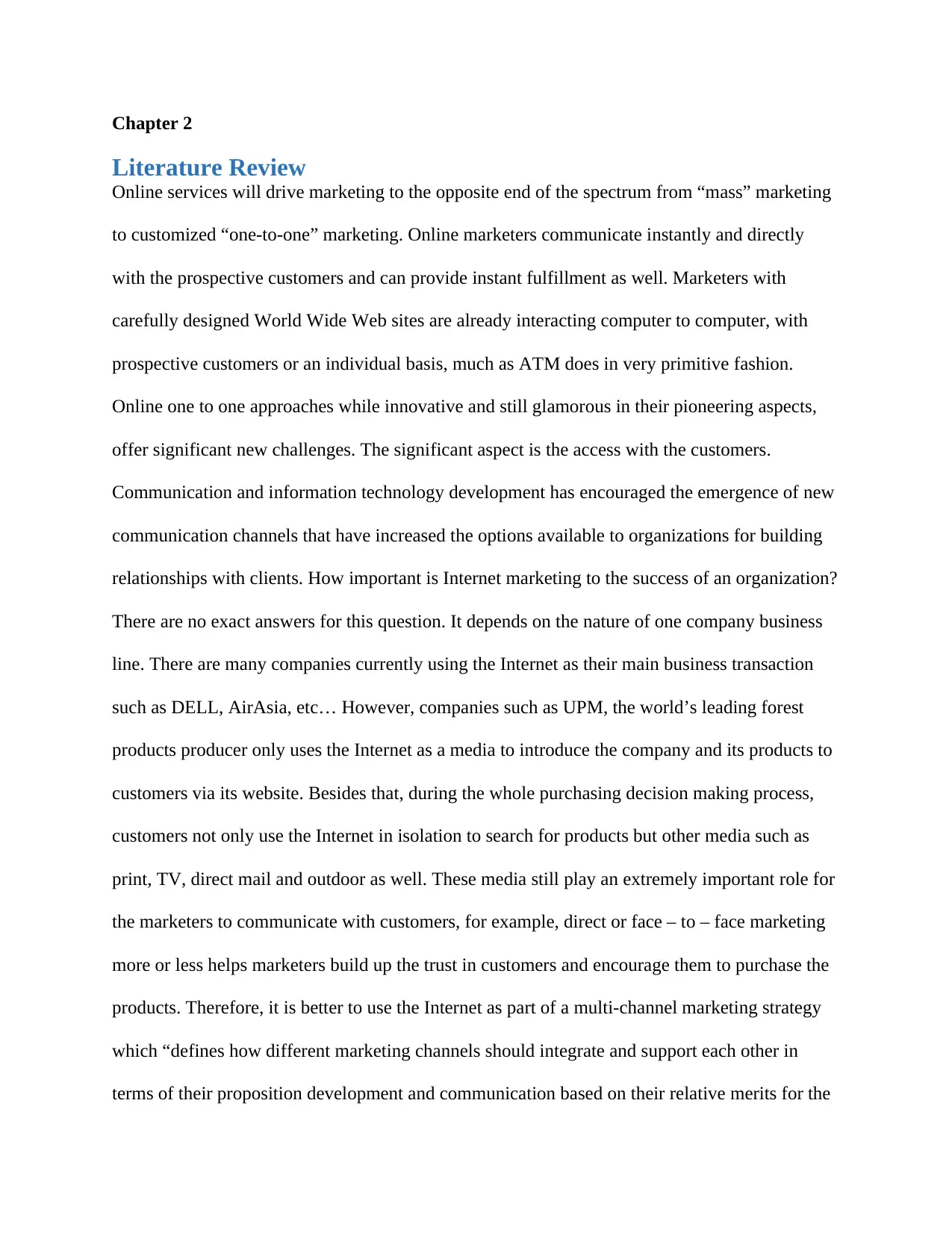
Chapter 2
Literature Review
Online services will drive marketing to the opposite end of the spectrum from “mass” marketing
to customized “one-to-one” marketing. Online marketers communicate instantly and directly
with the prospective customers and can provide instant fulfillment as well. Marketers with
carefully designed World Wide Web sites are already interacting computer to computer, with
prospective customers or an individual basis, much as ATM does in very primitive fashion.
Online one to one approaches while innovative and still glamorous in their pioneering aspects,
offer significant new challenges. The significant aspect is the access with the customers.
Communication and information technology development has encouraged the emergence of new
communication channels that have increased the options available to organizations for building
relationships with clients. How important is Internet marketing to the success of an organization?
There are no exact answers for this question. It depends on the nature of one company business
line. There are many companies currently using the Internet as their main business transaction
such as DELL, AirAsia, etc… However, companies such as UPM, the world’s leading forest
products producer only uses the Internet as a media to introduce the company and its products to
customers via its website. Besides that, during the whole purchasing decision making process,
customers not only use the Internet in isolation to search for products but other media such as
print, TV, direct mail and outdoor as well. These media still play an extremely important role for
the marketers to communicate with customers, for example, direct or face – to – face marketing
more or less helps marketers build up the trust in customers and encourage them to purchase the
products. Therefore, it is better to use the Internet as part of a multi-channel marketing strategy
which “defines how different marketing channels should integrate and support each other in
terms of their proposition development and communication based on their relative merits for the
Literature Review
Online services will drive marketing to the opposite end of the spectrum from “mass” marketing
to customized “one-to-one” marketing. Online marketers communicate instantly and directly
with the prospective customers and can provide instant fulfillment as well. Marketers with
carefully designed World Wide Web sites are already interacting computer to computer, with
prospective customers or an individual basis, much as ATM does in very primitive fashion.
Online one to one approaches while innovative and still glamorous in their pioneering aspects,
offer significant new challenges. The significant aspect is the access with the customers.
Communication and information technology development has encouraged the emergence of new
communication channels that have increased the options available to organizations for building
relationships with clients. How important is Internet marketing to the success of an organization?
There are no exact answers for this question. It depends on the nature of one company business
line. There are many companies currently using the Internet as their main business transaction
such as DELL, AirAsia, etc… However, companies such as UPM, the world’s leading forest
products producer only uses the Internet as a media to introduce the company and its products to
customers via its website. Besides that, during the whole purchasing decision making process,
customers not only use the Internet in isolation to search for products but other media such as
print, TV, direct mail and outdoor as well. These media still play an extremely important role for
the marketers to communicate with customers, for example, direct or face – to – face marketing
more or less helps marketers build up the trust in customers and encourage them to purchase the
products. Therefore, it is better to use the Internet as part of a multi-channel marketing strategy
which “defines how different marketing channels should integrate and support each other in
terms of their proposition development and communication based on their relative merits for the
⊘ This is a preview!⊘
Do you want full access?
Subscribe today to unlock all pages.

Trusted by 1+ million students worldwide
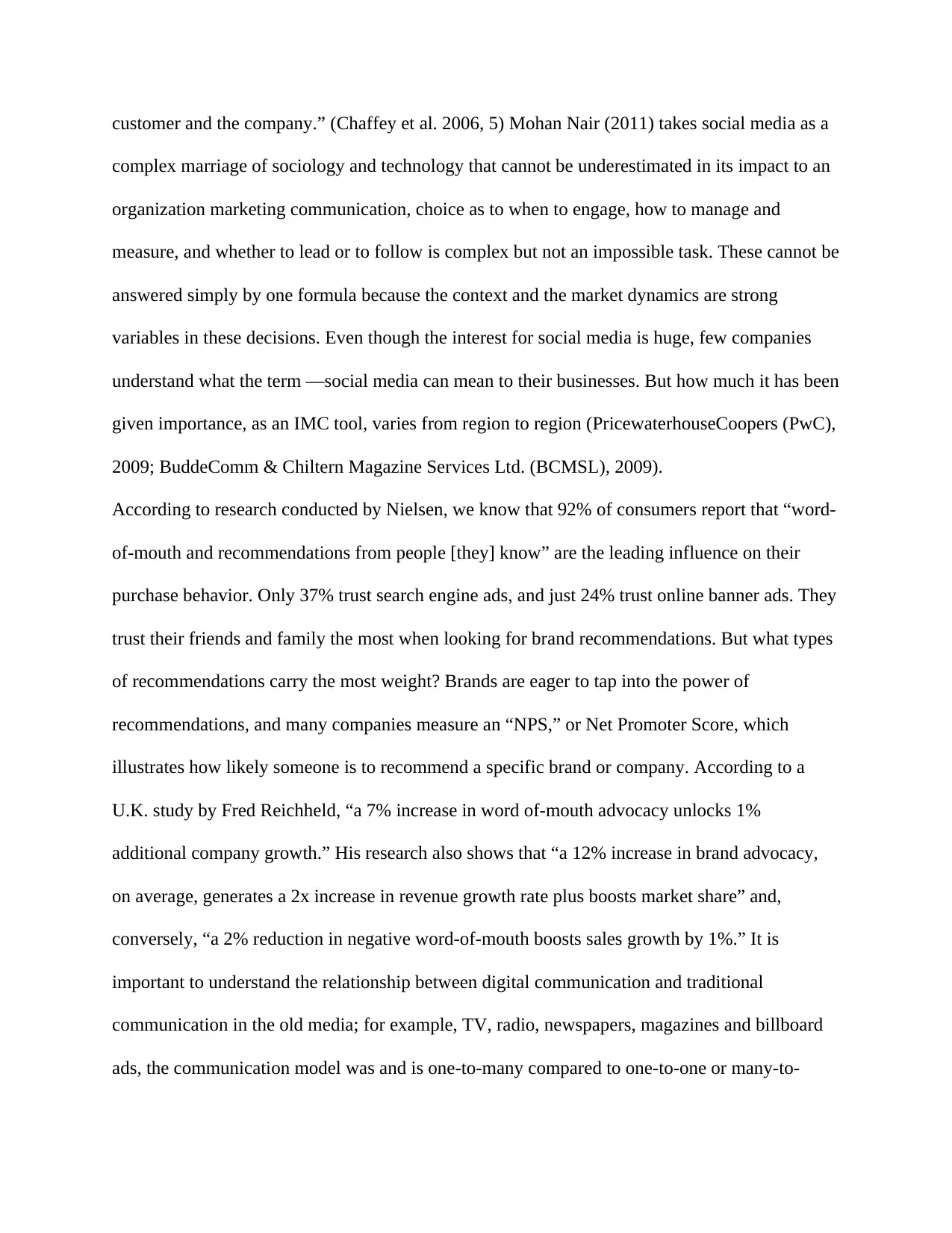
customer and the company.” (Chaffey et al. 2006, 5) Mohan Nair (2011) takes social media as a
complex marriage of sociology and technology that cannot be underestimated in its impact to an
organization marketing communication, choice as to when to engage, how to manage and
measure, and whether to lead or to follow is complex but not an impossible task. These cannot be
answered simply by one formula because the context and the market dynamics are strong
variables in these decisions. Even though the interest for social media is huge, few companies
understand what the term ―social media can mean to their businesses. But how much it has been
given importance, as an IMC tool, varies from region to region (PricewaterhouseCoopers (PwC),
2009; BuddeComm & Chiltern Magazine Services Ltd. (BCMSL), 2009).
According to research conducted by Nielsen, we know that 92% of consumers report that “word-
of-mouth and recommendations from people [they] know” are the leading influence on their
purchase behavior. Only 37% trust search engine ads, and just 24% trust online banner ads. They
trust their friends and family the most when looking for brand recommendations. But what types
of recommendations carry the most weight? Brands are eager to tap into the power of
recommendations, and many companies measure an “NPS,” or Net Promoter Score, which
illustrates how likely someone is to recommend a specific brand or company. According to a
U.K. study by Fred Reichheld, “a 7% increase in word of-mouth advocacy unlocks 1%
additional company growth.” His research also shows that “a 12% increase in brand advocacy,
on average, generates a 2x increase in revenue growth rate plus boosts market share” and,
conversely, “a 2% reduction in negative word-of-mouth boosts sales growth by 1%.” It is
important to understand the relationship between digital communication and traditional
communication in the old media; for example, TV, radio, newspapers, magazines and billboard
ads, the communication model was and is one-to-many compared to one-to-one or many-to-
complex marriage of sociology and technology that cannot be underestimated in its impact to an
organization marketing communication, choice as to when to engage, how to manage and
measure, and whether to lead or to follow is complex but not an impossible task. These cannot be
answered simply by one formula because the context and the market dynamics are strong
variables in these decisions. Even though the interest for social media is huge, few companies
understand what the term ―social media can mean to their businesses. But how much it has been
given importance, as an IMC tool, varies from region to region (PricewaterhouseCoopers (PwC),
2009; BuddeComm & Chiltern Magazine Services Ltd. (BCMSL), 2009).
According to research conducted by Nielsen, we know that 92% of consumers report that “word-
of-mouth and recommendations from people [they] know” are the leading influence on their
purchase behavior. Only 37% trust search engine ads, and just 24% trust online banner ads. They
trust their friends and family the most when looking for brand recommendations. But what types
of recommendations carry the most weight? Brands are eager to tap into the power of
recommendations, and many companies measure an “NPS,” or Net Promoter Score, which
illustrates how likely someone is to recommend a specific brand or company. According to a
U.K. study by Fred Reichheld, “a 7% increase in word of-mouth advocacy unlocks 1%
additional company growth.” His research also shows that “a 12% increase in brand advocacy,
on average, generates a 2x increase in revenue growth rate plus boosts market share” and,
conversely, “a 2% reduction in negative word-of-mouth boosts sales growth by 1%.” It is
important to understand the relationship between digital communication and traditional
communication in the old media; for example, TV, radio, newspapers, magazines and billboard
ads, the communication model was and is one-to-many compared to one-to-one or many-to-
Paraphrase This Document
Need a fresh take? Get an instant paraphrase of this document with our AI Paraphraser
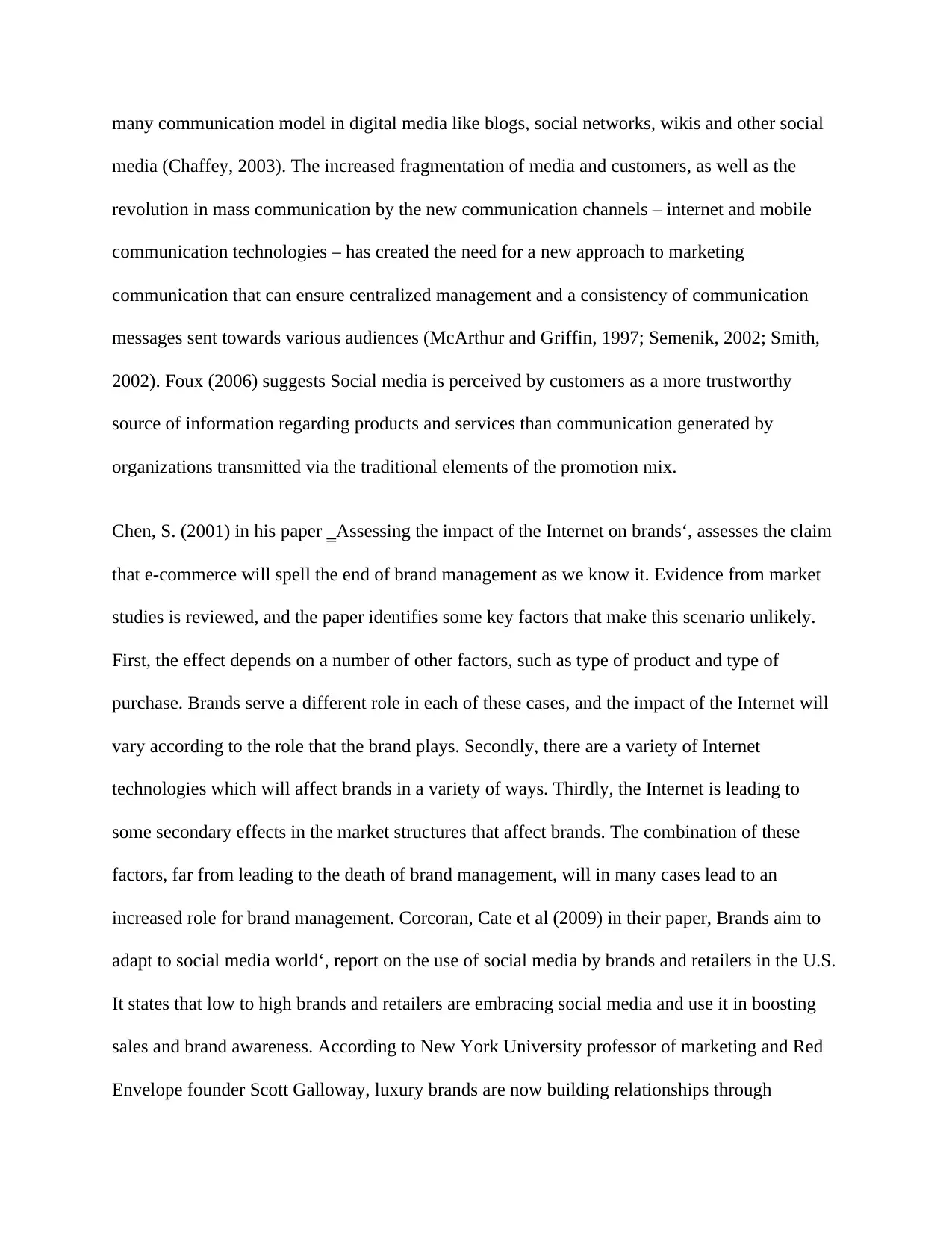
many communication model in digital media like blogs, social networks, wikis and other social
media (Chaffey, 2003). The increased fragmentation of media and customers, as well as the
revolution in mass communication by the new communication channels – internet and mobile
communication technologies – has created the need for a new approach to marketing
communication that can ensure centralized management and a consistency of communication
messages sent towards various audiences (McArthur and Griffin, 1997; Semenik, 2002; Smith,
2002). Foux (2006) suggests Social media is perceived by customers as a more trustworthy
source of information regarding products and services than communication generated by
organizations transmitted via the traditional elements of the promotion mix.
Chen, S. (2001) in his paper ‗Assessing the impact of the Internet on brands‘, assesses the claim
that e-commerce will spell the end of brand management as we know it. Evidence from market
studies is reviewed, and the paper identifies some key factors that make this scenario unlikely.
First, the effect depends on a number of other factors, such as type of product and type of
purchase. Brands serve a different role in each of these cases, and the impact of the Internet will
vary according to the role that the brand plays. Secondly, there are a variety of Internet
technologies which will affect brands in a variety of ways. Thirdly, the Internet is leading to
some secondary effects in the market structures that affect brands. The combination of these
factors, far from leading to the death of brand management, will in many cases lead to an
increased role for brand management. Corcoran, Cate et al (2009) in their paper, Brands aim to
adapt to social media world‘, report on the use of social media by brands and retailers in the U.S.
It states that low to high brands and retailers are embracing social media and use it in boosting
sales and brand awareness. According to New York University professor of marketing and Red
Envelope founder Scott Galloway, luxury brands are now building relationships through
media (Chaffey, 2003). The increased fragmentation of media and customers, as well as the
revolution in mass communication by the new communication channels – internet and mobile
communication technologies – has created the need for a new approach to marketing
communication that can ensure centralized management and a consistency of communication
messages sent towards various audiences (McArthur and Griffin, 1997; Semenik, 2002; Smith,
2002). Foux (2006) suggests Social media is perceived by customers as a more trustworthy
source of information regarding products and services than communication generated by
organizations transmitted via the traditional elements of the promotion mix.
Chen, S. (2001) in his paper ‗Assessing the impact of the Internet on brands‘, assesses the claim
that e-commerce will spell the end of brand management as we know it. Evidence from market
studies is reviewed, and the paper identifies some key factors that make this scenario unlikely.
First, the effect depends on a number of other factors, such as type of product and type of
purchase. Brands serve a different role in each of these cases, and the impact of the Internet will
vary according to the role that the brand plays. Secondly, there are a variety of Internet
technologies which will affect brands in a variety of ways. Thirdly, the Internet is leading to
some secondary effects in the market structures that affect brands. The combination of these
factors, far from leading to the death of brand management, will in many cases lead to an
increased role for brand management. Corcoran, Cate et al (2009) in their paper, Brands aim to
adapt to social media world‘, report on the use of social media by brands and retailers in the U.S.
It states that low to high brands and retailers are embracing social media and use it in boosting
sales and brand awareness. According to New York University professor of marketing and Red
Envelope founder Scott Galloway, luxury brands are now building relationships through
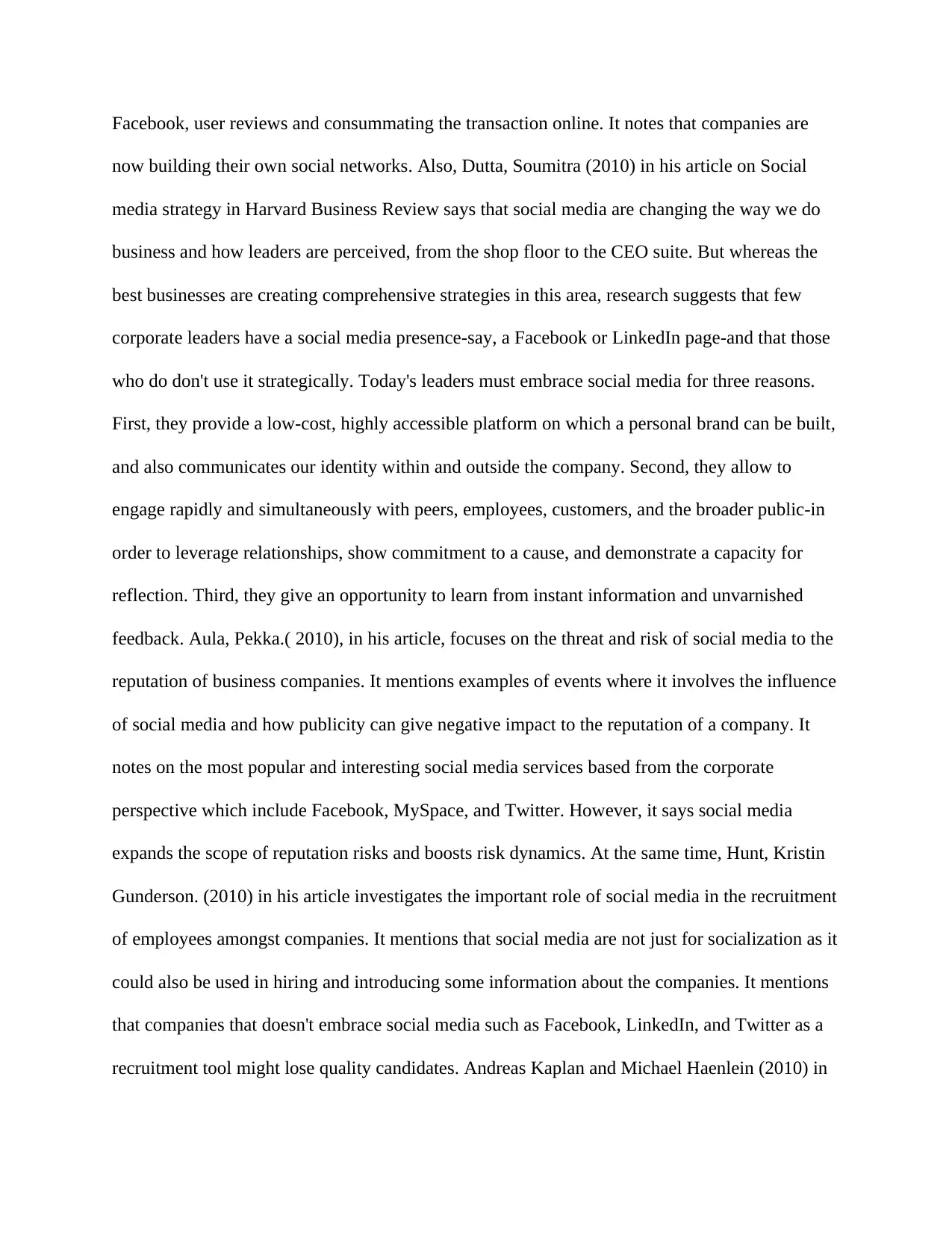
Facebook, user reviews and consummating the transaction online. It notes that companies are
now building their own social networks. Also, Dutta, Soumitra (2010) in his article on Social
media strategy in Harvard Business Review says that social media are changing the way we do
business and how leaders are perceived, from the shop floor to the CEO suite. But whereas the
best businesses are creating comprehensive strategies in this area, research suggests that few
corporate leaders have a social media presence-say, a Facebook or LinkedIn page-and that those
who do don't use it strategically. Today's leaders must embrace social media for three reasons.
First, they provide a low-cost, highly accessible platform on which a personal brand can be built,
and also communicates our identity within and outside the company. Second, they allow to
engage rapidly and simultaneously with peers, employees, customers, and the broader public-in
order to leverage relationships, show commitment to a cause, and demonstrate a capacity for
reflection. Third, they give an opportunity to learn from instant information and unvarnished
feedback. Aula, Pekka.( 2010), in his article, focuses on the threat and risk of social media to the
reputation of business companies. It mentions examples of events where it involves the influence
of social media and how publicity can give negative impact to the reputation of a company. It
notes on the most popular and interesting social media services based from the corporate
perspective which include Facebook, MySpace, and Twitter. However, it says social media
expands the scope of reputation risks and boosts risk dynamics. At the same time, Hunt, Kristin
Gunderson. (2010) in his article investigates the important role of social media in the recruitment
of employees amongst companies. It mentions that social media are not just for socialization as it
could also be used in hiring and introducing some information about the companies. It mentions
that companies that doesn't embrace social media such as Facebook, LinkedIn, and Twitter as a
recruitment tool might lose quality candidates. Andreas Kaplan and Michael Haenlein (2010) in
now building their own social networks. Also, Dutta, Soumitra (2010) in his article on Social
media strategy in Harvard Business Review says that social media are changing the way we do
business and how leaders are perceived, from the shop floor to the CEO suite. But whereas the
best businesses are creating comprehensive strategies in this area, research suggests that few
corporate leaders have a social media presence-say, a Facebook or LinkedIn page-and that those
who do don't use it strategically. Today's leaders must embrace social media for three reasons.
First, they provide a low-cost, highly accessible platform on which a personal brand can be built,
and also communicates our identity within and outside the company. Second, they allow to
engage rapidly and simultaneously with peers, employees, customers, and the broader public-in
order to leverage relationships, show commitment to a cause, and demonstrate a capacity for
reflection. Third, they give an opportunity to learn from instant information and unvarnished
feedback. Aula, Pekka.( 2010), in his article, focuses on the threat and risk of social media to the
reputation of business companies. It mentions examples of events where it involves the influence
of social media and how publicity can give negative impact to the reputation of a company. It
notes on the most popular and interesting social media services based from the corporate
perspective which include Facebook, MySpace, and Twitter. However, it says social media
expands the scope of reputation risks and boosts risk dynamics. At the same time, Hunt, Kristin
Gunderson. (2010) in his article investigates the important role of social media in the recruitment
of employees amongst companies. It mentions that social media are not just for socialization as it
could also be used in hiring and introducing some information about the companies. It mentions
that companies that doesn't embrace social media such as Facebook, LinkedIn, and Twitter as a
recruitment tool might lose quality candidates. Andreas Kaplan and Michael Haenlein (2010) in
⊘ This is a preview!⊘
Do you want full access?
Subscribe today to unlock all pages.

Trusted by 1+ million students worldwide
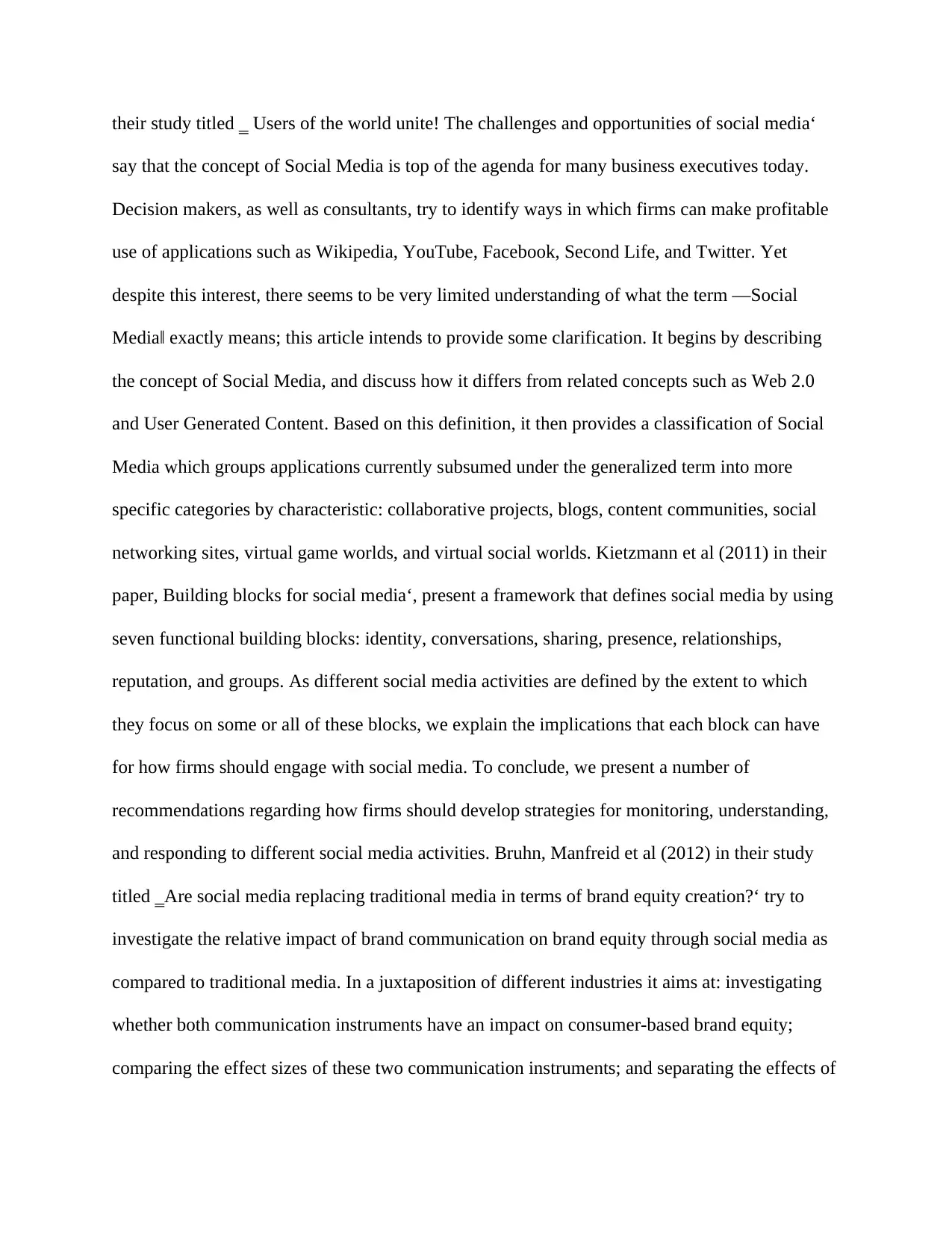
their study titled ‗ Users of the world unite! The challenges and opportunities of social media‘
say that the concept of Social Media is top of the agenda for many business executives today.
Decision makers, as well as consultants, try to identify ways in which firms can make profitable
use of applications such as Wikipedia, YouTube, Facebook, Second Life, and Twitter. Yet
despite this interest, there seems to be very limited understanding of what the term ―Social
Media‖ exactly means; this article intends to provide some clarification. It begins by describing
the concept of Social Media, and discuss how it differs from related concepts such as Web 2.0
and User Generated Content. Based on this definition, it then provides a classification of Social
Media which groups applications currently subsumed under the generalized term into more
specific categories by characteristic: collaborative projects, blogs, content communities, social
networking sites, virtual game worlds, and virtual social worlds. Kietzmann et al (2011) in their
paper, Building blocks for social media‘, present a framework that defines social media by using
seven functional building blocks: identity, conversations, sharing, presence, relationships,
reputation, and groups. As different social media activities are defined by the extent to which
they focus on some or all of these blocks, we explain the implications that each block can have
for how firms should engage with social media. To conclude, we present a number of
recommendations regarding how firms should develop strategies for monitoring, understanding,
and responding to different social media activities. Bruhn, Manfreid et al (2012) in their study
titled ‗Are social media replacing traditional media in terms of brand equity creation?‘ try to
investigate the relative impact of brand communication on brand equity through social media as
compared to traditional media. In a juxtaposition of different industries it aims at: investigating
whether both communication instruments have an impact on consumer-based brand equity;
comparing the effect sizes of these two communication instruments; and separating the effects of
say that the concept of Social Media is top of the agenda for many business executives today.
Decision makers, as well as consultants, try to identify ways in which firms can make profitable
use of applications such as Wikipedia, YouTube, Facebook, Second Life, and Twitter. Yet
despite this interest, there seems to be very limited understanding of what the term ―Social
Media‖ exactly means; this article intends to provide some clarification. It begins by describing
the concept of Social Media, and discuss how it differs from related concepts such as Web 2.0
and User Generated Content. Based on this definition, it then provides a classification of Social
Media which groups applications currently subsumed under the generalized term into more
specific categories by characteristic: collaborative projects, blogs, content communities, social
networking sites, virtual game worlds, and virtual social worlds. Kietzmann et al (2011) in their
paper, Building blocks for social media‘, present a framework that defines social media by using
seven functional building blocks: identity, conversations, sharing, presence, relationships,
reputation, and groups. As different social media activities are defined by the extent to which
they focus on some or all of these blocks, we explain the implications that each block can have
for how firms should engage with social media. To conclude, we present a number of
recommendations regarding how firms should develop strategies for monitoring, understanding,
and responding to different social media activities. Bruhn, Manfreid et al (2012) in their study
titled ‗Are social media replacing traditional media in terms of brand equity creation?‘ try to
investigate the relative impact of brand communication on brand equity through social media as
compared to traditional media. In a juxtaposition of different industries it aims at: investigating
whether both communication instruments have an impact on consumer-based brand equity;
comparing the effect sizes of these two communication instruments; and separating the effects of
Paraphrase This Document
Need a fresh take? Get an instant paraphrase of this document with our AI Paraphraser
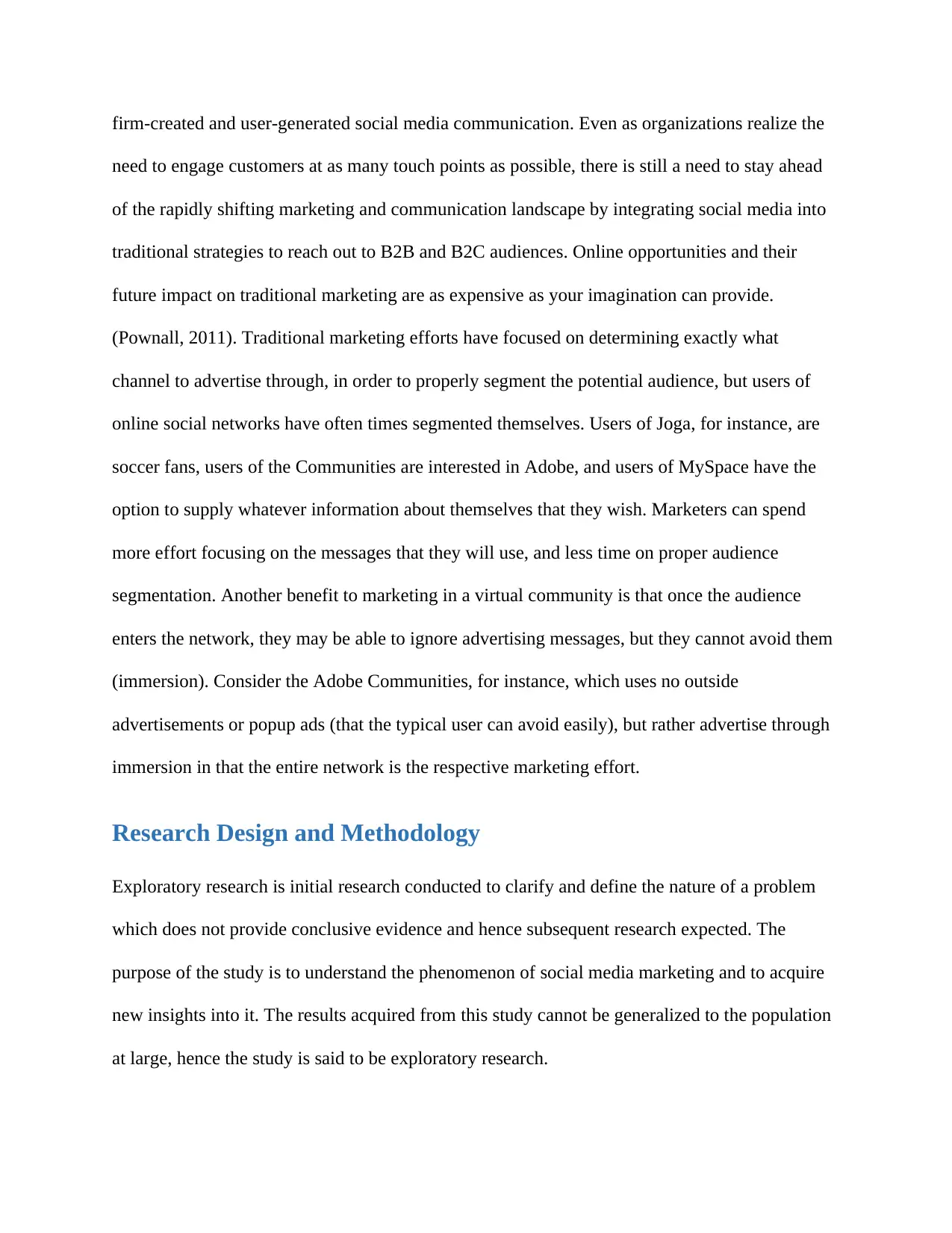
firm-created and user-generated social media communication. Even as organizations realize the
need to engage customers at as many touch points as possible, there is still a need to stay ahead
of the rapidly shifting marketing and communication landscape by integrating social media into
traditional strategies to reach out to B2B and B2C audiences. Online opportunities and their
future impact on traditional marketing are as expensive as your imagination can provide.
(Pownall, 2011). Traditional marketing efforts have focused on determining exactly what
channel to advertise through, in order to properly segment the potential audience, but users of
online social networks have often times segmented themselves. Users of Joga, for instance, are
soccer fans, users of the Communities are interested in Adobe, and users of MySpace have the
option to supply whatever information about themselves that they wish. Marketers can spend
more effort focusing on the messages that they will use, and less time on proper audience
segmentation. Another benefit to marketing in a virtual community is that once the audience
enters the network, they may be able to ignore advertising messages, but they cannot avoid them
(immersion). Consider the Adobe Communities, for instance, which uses no outside
advertisements or popup ads (that the typical user can avoid easily), but rather advertise through
immersion in that the entire network is the respective marketing effort.
Research Design and Methodology
Exploratory research is initial research conducted to clarify and define the nature of a problem
which does not provide conclusive evidence and hence subsequent research expected. The
purpose of the study is to understand the phenomenon of social media marketing and to acquire
new insights into it. The results acquired from this study cannot be generalized to the population
at large, hence the study is said to be exploratory research.
need to engage customers at as many touch points as possible, there is still a need to stay ahead
of the rapidly shifting marketing and communication landscape by integrating social media into
traditional strategies to reach out to B2B and B2C audiences. Online opportunities and their
future impact on traditional marketing are as expensive as your imagination can provide.
(Pownall, 2011). Traditional marketing efforts have focused on determining exactly what
channel to advertise through, in order to properly segment the potential audience, but users of
online social networks have often times segmented themselves. Users of Joga, for instance, are
soccer fans, users of the Communities are interested in Adobe, and users of MySpace have the
option to supply whatever information about themselves that they wish. Marketers can spend
more effort focusing on the messages that they will use, and less time on proper audience
segmentation. Another benefit to marketing in a virtual community is that once the audience
enters the network, they may be able to ignore advertising messages, but they cannot avoid them
(immersion). Consider the Adobe Communities, for instance, which uses no outside
advertisements or popup ads (that the typical user can avoid easily), but rather advertise through
immersion in that the entire network is the respective marketing effort.
Research Design and Methodology
Exploratory research is initial research conducted to clarify and define the nature of a problem
which does not provide conclusive evidence and hence subsequent research expected. The
purpose of the study is to understand the phenomenon of social media marketing and to acquire
new insights into it. The results acquired from this study cannot be generalized to the population
at large, hence the study is said to be exploratory research.
1 out of 11
Related Documents
Your All-in-One AI-Powered Toolkit for Academic Success.
+13062052269
info@desklib.com
Available 24*7 on WhatsApp / Email
![[object Object]](/_next/static/media/star-bottom.7253800d.svg)
Unlock your academic potential
Copyright © 2020–2025 A2Z Services. All Rights Reserved. Developed and managed by ZUCOL.





